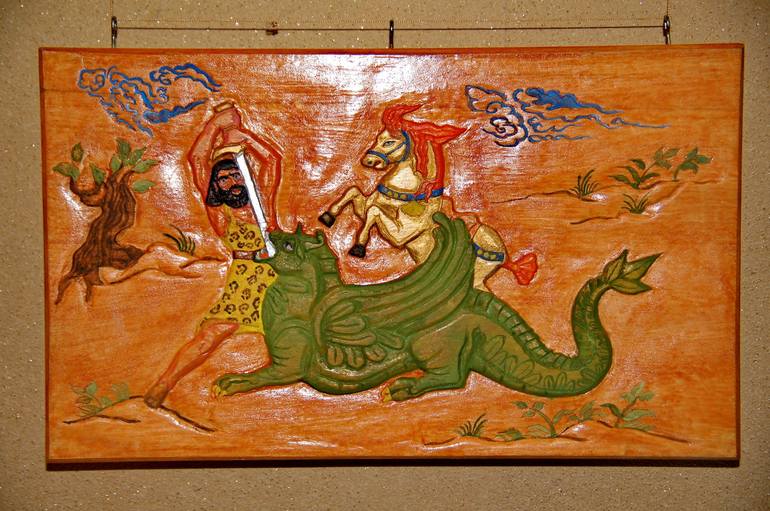Persian folklore brims with legendary creatures that reflect the region’s rich tapestry of belief, myth, and artistic tradition. From fearsome dragons to malevolent Divs and the majestic Simurgh, each being embodies timeless themes of chaos versus order, wisdom, and the interplay between the human and the divine. Join us on a journey through these three iconic creatures, their origins, tales, and enduring cultural impact.
1. Dragons (Azhdaha): Serpents of Chaos and Challenge
In Persian myth, dragons—often called Azhdaha—mirror elemental fury and chaos. Unlike Western dragons that hoard treasure, Persian dragons are primeval forces that heroes must overcome:
-
Origins & Role: Emerging from primordial darkness, Azhdaha symbolize drought, disease, and the untamed wild.
-
Epic Encounters: Legendary figures like Esfandiyar and Zal battle these serpentine beasts. In some versions, Alexander the Great (Sikandar) faces a dragon during his eastern conquests .
-
Artistic Depictions: Persian miniatures show Azhdaha as long, sinuous creatures with scaled bodies and clawed feet. Their colorful patterns convey both beauty and terror, often painted alongside heroic figures in illuminated manuscripts.
Dragons remind us that order and civilization must be won through bravery and sacrifice.
2. Divs: Demons of Deception and Strife
Divs (from Middle Persian dēw), akin to demons or ogres, represent moral corruption, envy, and temptation. Rooted in Zoroastrian dualism, they serve the dark spirit Ahriman:
-
Characteristics: Divs vary in color and size—white Divs embody cunning, red Divs represent wrath, and black Divs embody despair.
-
Ferdowsi’s Narratives: In the Shahnameh, heroes like Rostam and Giv slay vicious Divs to protect their people. One famous tale recounts Rostam rescuing King Kay Kāvus from a demon’s lair by defeating the White Div .
-
Cultural Symbolism: Beyond physical foes, Divs symbolize inner vices. Their defeat signifies not only martial prowess but spiritual triumph.
Divs teach that the greatest battles are often against the darker elements within and around us.
3. The Simurgh: Guardian of Wisdom and Healing
Towering above these fearsome beings stands the Simurgh, a benevolent, phoenix‑like creature whose very name suggests “thirty birds” or “thirty valleys” in Old Persian:
-
Mythic Lore: According to the Shahnameh, the Simurgh rescues the abandoned prince Zal, nursing him until he matures into a wise leader. Later, the Simurgh’s feather heals the wounded Rostam, exemplifying compassion and divine favor .
-
Symbolic Depth: A fusion of bird and mammal features—like feathered wings and leonine claws—the Simurgh bridges the natural and supernatural. It embodies unity, healing, and the hidden knowledge that lies beyond mortal sight.
-
Influence on Sufi Thought: In Attar’s Conference of the Birds, the Simurgh represents the ultimate truth—revealing that the divine resides within each seeker.
The Simurgh’s presence in art and poetry underscores hope, renewal, and the pursuit of enlightenment.
4. Enduring Legacy in Art & Culture
-
Manuscript Miniatures: From 14th‑century Ilkhanid masterpieces to Safavid courtly albums, artists have immortalized dragons, Divs, and the Simurgh in vivid pigment and gold leaf.
-
Textiles & Architecture: Motifs echo through Persian carpets, ceramics, and tilework—writhing dragons on palace walls, winged Simurghs guarding mausoleums, and Div‑like grotesques marking thresholds.
-
Modern Revivals: Contemporary Iranian filmmakers, novelists, and painters reimagine these creatures to explore themes of identity, morality, and the tension between tradition and modernity.
5. Why These Myths Matter Today
Mythical creatures from Persian folklore continue to captivate because they address universal questions:
-
Chaos vs. Order: Dragons challenge the boundaries of civilization.
-
Inner Demons: Divs externalize our struggles with fear, anger, and envy.
-
Quest for Wisdom: The Simurgh embodies the healer‑guide within us all.
By revisiting these tales, we reconnect with ancient archetypes—discovering that even in our digital age, the human heart still resonates with stories of monsters, demons, and transcendent guardians.
Ready to explore further? Seek out illustrated editions of the Shahnameh or visit museum collections featuring Persian miniatures. Each page turn and gallery wall brings you closer to the vibrant world where dragons soared, Divs lurked, and the Simurgh watched over heroes from the dawn of Persian legend.





